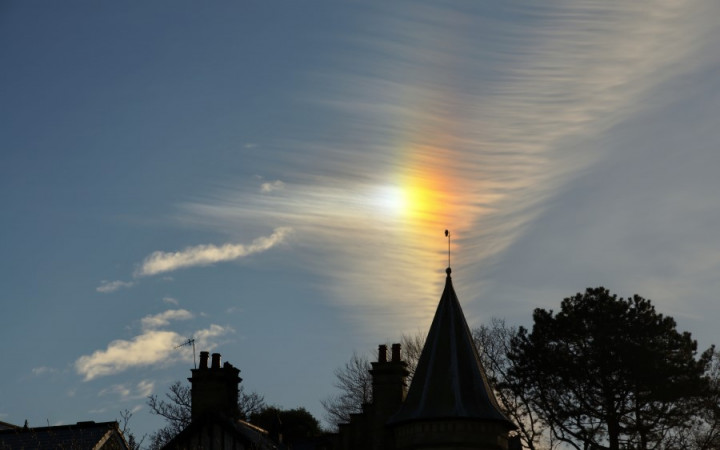Today’s Wonder of the Day was inspired by Rhonda . Rhonda Wonders, “What is a sun dog?” Thanks for WONDERing with us, Rhonda !
What's that bright orb up in the sky? Yes, it's probably the Sun. But if it has been cloudy for days on end, especially during a rainy spring, the sudden appearance of the Sun can seem like a celestial mystery.
Even more mysterious is the appearance of bright, colorful patches of light on each side of the Sun. If you've ever seen this curious phenomenon, you may have been WONDERing if you were seeing double or even triple. No need to get your eyes checked, though, you were probably just seeing sun dogs.
Sun dogs don't , and they don't wag their tails. They also won't eat your homework. What they will do, however, is amaze onlookers and get people pointing up at the sky.
Bright, colored areas of light beside the Sun are known as sun dogs (sometimes written as one word: sundogs). They're often approximately 22 degrees to the left or the right (or both!) and about the same distance above the horizon as the Sun. They're also often seen as part of a ring or halo around the Sun.
Sun dogs are known as parhelia (singular: parhelion) in the scientific community, which comes from the Greek words meaning "beside the Sun." Other common names for sun dogs include mock or phantom suns.
Sun dogs form when there are hexagonal ice crystals in high, cold cirrus clouds. They can also form when ice crystals float in the air during extremely cold weather. Although sun dogs are more common when cold weather brings ice crystals into the atmosphere, they can occur anywhere in the world any time there are cirrus clouds.
Ice crystals in the air act like prisms, bending the Sun's rays and refracting them in such a way that sun dogs appear. Because of the way that the Sun's light gets bent, sun dogs will often appear red on the side closest to the Sun with a blue or white tail stretching horizontally away from the Sun.
Scientists don't know how the term "sun dog" originated. Historians do know that the term has been around in art and literature for well over a century. Some experts believe the term may have arisen by way of comparing how parhelia follow the Sun to the way a dog follows its master.
The sun dog phenomenon can also occur at night when the Moon is nearly full and particularly bright. These moon dogs, or paraselenae, aren't seen nearly as often as sun dogs, because the conditions necessary for their formation don't happen very frequently.





